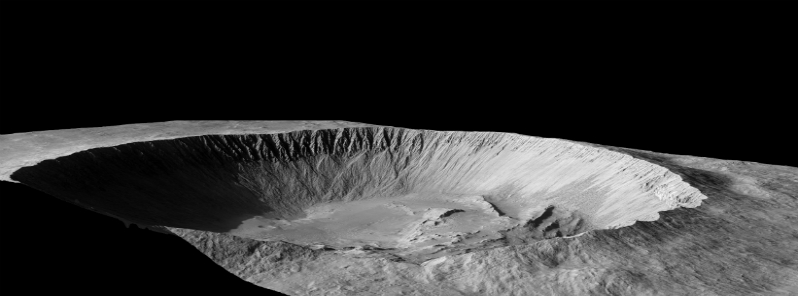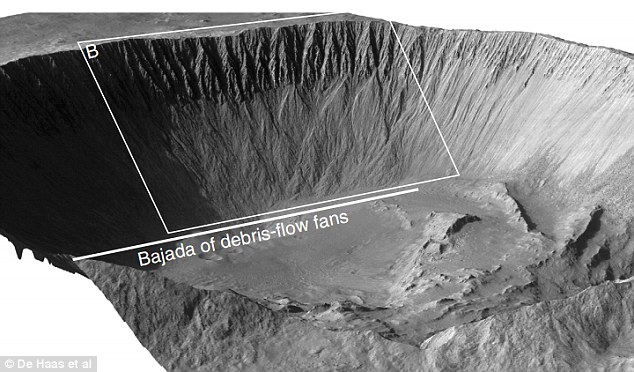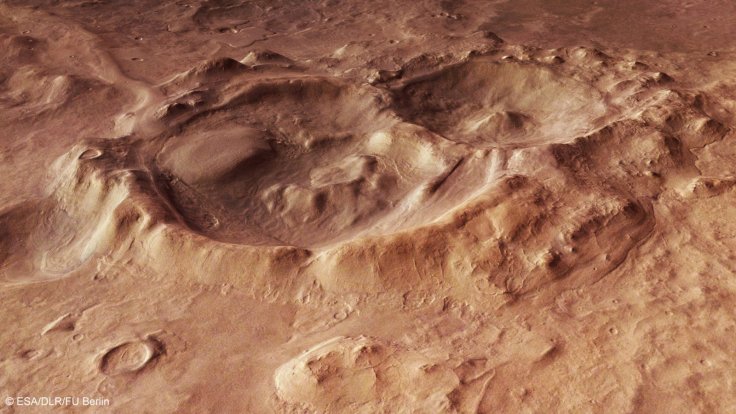Istok crater on Mars hints at Earth-like climate

A new study of young Istok crater led by Tjalling de Haas of Utrecht University in the Netherlands reveals that Mars, a planet of paradoxes, may have had a climate that resembles that of our own in the recent past.
Istok crater, located in the Aonia Terra region of Mars, has well defined gullies. The European scientists based their conclusion on these gullies which suggest that waterlogged debris flowed down slopes.
Researchers used data from the HiRISE camera on NASA's Mars Reconnaissance Orbiter to map out the gullies in three-dimensional detail and compared them with similar gullies carved on Earth in Iceland or Atacama desert.
At present Mars is extremely dry and cold. It's thin atmosphere makes liquid water on it 's surface evaporate quickly. However, high orbital obliquity in the last few million years have brought changes in its climatic conditions. Obliquity here refers to the ‘axial tilt’ of Mars – the angle between its poles and its orbital plane.
Like Earth's axis, Mars's tilt has shifted during the glacial-interglacial period, but from a slight 15 degrees to a strong 35 degrees. So, at some point, the Red Planet was tilted towards the Sun more than it is now and therefore experienced unusual warm temperatures at it's poles. This caused the ice at the poles to sublimate as water vapour and fall as snow. Snow/ice probably melted during high-obliquity periods in favourable locations, forming thousands of gullies in the mid-latitudes.
Some gullies were formed during the last few million years and as such, they are the youngest record of liquid water and extensive water activity on the surface of Mars. This was due to a favorable tilt of Mars just 500 000 years ago, and a similar tilt will occur again in 140 000 years.
Previously it was thought that the gullies might have been formed by just millimeters of water. Dr. de Haas disagrees with that. His team calculated that inches or even feet of snow had to pile up at the heads of these valleys in order to explain the debris flow patterns visible in the images taken from orbit. It's noted that the amount of water is not great – it is just enough for debris flows, although not seemingly enough to form lakes, rivers or pools. According to Tjalling de Haas, the debris flows had 20% to 30% water content in them.

The research showed that debris flows on Mars, caused by water, must have been much stronger than previously anticipated. They worked this out by examining the pole-facing slope of the Istok crater (shown), which hosts a series of ‘fans’ known as bajada, with abundant debris-flow deposits present. Image credit: De Haas et al.
As the gullies on the young crater are the youngest record of aqueous activity on the surface of Mars, they are of crucial importance in explaining the recent hydrological and climatic history of Mars. However, De Haas cautions that his team identified only “a local occurrence, and only during very short periods at high orbital obliquity.” Gullies in other locations do not indicate recent happenings as at Istok. This means that either the weather at Istok was localized or the source of water was different.

Many gullies on Mars' craters indicate similar flows though not as recent as at Istok, which suggests that the weather was either localized or the source of water was different. Image credit: ESA/DLR/FU Berlin.
The research was published on June 23, 2015 in the journal Nature Communications. It is highly expected that the research will greatly contribute to the understanding of the dynamic climatic history of Mars.
Featured image: Debris flows in Istok crater on Mars (Image source: NASA/JPL/University of Arizona)

Commenting rules and guidelines
We value the thoughts and opinions of our readers and welcome healthy discussions on our website. In order to maintain a respectful and positive community, we ask that all commenters follow these rules:
We reserve the right to remove any comments that violate these rules. By commenting on our website, you agree to abide by these guidelines. Thank you for helping to create a positive and welcoming environment for all.